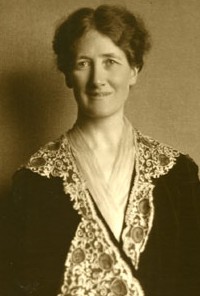Margaret Murray in Her Own Words September 15, 2015
Author: Beach Combing | in : Contemporary, Medieval, Modern , trackbackMargaret Murray (obit 1963) was a brilliantly creative and ill disciplined scholar who not satisfied with the mysteries of the pyramids (she was an Egyptologist) decided to sort out European witchcraft in two books: The Witch Cult in Western Europe (1921) and The God of the Witches (1931). Modern scholars universally reject her methods, while some, e.g. Emma Wilby (and this blogger), have a sneaking interest in the broad strokes of her theories. The following is a newspaper interview from 1929 when she was at the very height of her reputation and the weak foundations on which her wicca monolith had been built had not yet been dragged down by academic grappling hooks. MM, for all her faults, was lucid. But even the best professors are more lucid when they speak than when they write and so there is some value in her comments here, where she spells out her ideas: a beguiling combination of modern psychology and romantic paganism. Beach particularly enjoyed the bit where she considered to join a coven.
Witches, both male and female exist even to-day in practically all the country parts of Britain. They are very common in the West Country and East Anglia—there are even some in the towns. In the country, witches are looked up to and feared by the native population, who believe they can work terrible vengeance if offended. On the other hand, country people often go to them for help in times of trouble and sickness, and very often they are benefited. In France there is a witches’ secret society which has ramifications all over the country, and I believe the same sort of organisation exists in this country, though I have never been able to join. The difficulty is that one has to take a solemn oath of secrecy before the secrets the craft are disclosed, and once I had taken the oath I could not very well break it. There is great deal more in witchcraft than townspeople suppose. Strange things do happen the country, and for many of them witches arc responsible.
Much of Murray’s work involved theorizing about ‘herbs’, which she used to explain many paranormal powers of witches.
The essential qualifications of witches are an intimate knowledge of the uses of herbs, which are after all, the foundation of modern medicine, and an ability powerfully to impress their personalities upon other people. Not all witches are ignorant by any means, and the herbs which they employ have powerful properties which experience teaches them how to use. Witches can work in other ways, notably by the power of suggestion. For example, they might suggest to a certain person that he was going to die on a particular day. If he happened to have an illness about that time and be superstitious, as most country people are, the chances are that would die on that particular day. The power of the suggestion would such that the victim would die of fright. I am convinced that that is how many of the strange occurrences have been caused. A very common complaint in country districts in which milk churning is not done by machine is that the milk will not turn into butter. The blame is laid sometimes with justice the door of the local witch. In this case it is an example of the guile which all witches practice in order to keep up their reputations, and sometimes revenge. Certain powdered herbs dropped into the milk would prevent it from turning to butter. In the old days a dairymaid might not above doing this for some pretty ribbon. To-day an up-to-date witch might drop some soda into the milk with the same result. The net result to the witch, however, would that her reputation would go up, and also she might very likely receive some propitiatory gift, an inducement to remove the spell. Toads have always been associated with the deadly charms used witches. I have discovered that the liquid distilled from a toad’s skin a deadly poison. In the old days, I believe that many strange deaths believed to have been worked by witches’ charms were managed by anointing the victim’s clothes with it.
Finally, she moves on to the question of flying ointments: readers of Murray will remember the fifth appendix to her The Witch Cult (written by A.J.Clark).
Another curious discovery I made was an analysis of an ointment with which witches anointed themselves. It is called ‘flying ointment,’ and is supposed to have had the property of enabling witches to fly. A witch would anoint herself and go to bed to awaken the next morning firmly convinced that she had flown. This ointment. I discovered, contained aconite, which has powerful effect on the heart. My theory is that making the action of the heart irregular the ointment would produce physical symptoms similar to those flying, and that these would probably accompanied by a dream about flying. Not Ev Post, 12 Jun 1929
Other thoughts on MM: drbeachcombing AT yahoo DOT com



